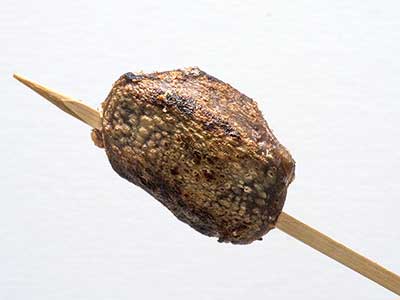January 5, 2015
Amuse-Bouche

gésier rôti
(seared gizzard)
“Do you fret your gizzard?” That’s a question that Dr. Johnson may have asked you if you seemed apprehensive. In the literary world, there seems to be an illusion that we have a body part called a gizzard. Samuel Pepys wrote in his diary on June 17th, 1668, “I find my wife hath something in her gizzard that which waits an opportunity of being provoked to bring up.” In 1738, Jonathan Swift wrote in A complete collection of genteel and ingenious conversation, according to the most polite mode and method now used at court, and in the best companies of England, “Don't let that stick in your gizzard.” Do you know where your gizzard is? There are some similar parts that we share with fowl but not quadrupeds, such as clavicles, but the gizzard is not one of them. Humans only have a figurative gizzard. Quadrupeds have no gizzard at all.
In cooking, the gizzard is often included with the giblets, a term for the edible offal of a fowl, typically including the heart, gizzard, liver, and other visceral organs. That’s how I knew it as a child. The gizzard was always part of the giblet gravy my mother prepared with turkey. I never knew it to be a solo food item until I traveled to France and had my first duck-gizzard salad. Now whenever I feel like making one of those salads, I head to one of my local Asian markets where duck gizzards, split in two, trimmed, and cleaned of their grit and grain, are always available. I’ve never seen them in Whole Foods or Safeway.
I thoroughly enjoyed that first gizzard salad I was served in France, and I soon learned how to prepare the gizzards for it. The process starts with a traditional confit: Cook the duck gizzards slowly in duck fat. When tender, the gizzards are cooled in the fat. They, like any other confit, can be preserved in the fat for long-term storage. For almost two decades, that’s how I cooked my gizzards.
Recently, I was perusing the aisles of a local Vietnamese grocery store in a fruitless search for ammonia powder. In one of the refrigerated cases were packages of duck gizzards, and I bought one. The morning I decided to confit the gizzards I abruptly remembered that I was out of both duck and goose fat. I thought to myself, “What’s the most important aspect of the confit process? Low heat or fat for heat transfer.” I decided the answer was low heat.
The gizzards were generously salted and chilled for an hour or so. When the time was up, they were rinsed and patted dry. Some black pepper and dried thyme leaves were sprinkled over the gizzards before they were vacuum-packed in a single layer. Then they were cooked in a 65 °C (149 °F) water bath for about 24 hours.
Since I planned to use them individually, at the end of their cooking, the gizzards, along with their exuded juices, were transferred to a plastic container. If being used en masse, they could be left in the vacuum bag until needed.
For a traditional salad, the gizzards are quickly pan-fried in hot fat until their surfaces darken, and they are heated through. This method could be used for serving individual gizzards as an amuse-bouche, but I had a new toy: The Searzall. To sear with the Searzall, the cold gizzards were threaded on to a flat, metal skewer. For service, each gizzard was transferred to its own wooden skewer.
© 2015 Peter Hertzmann. All rights reserved.
